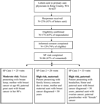Genetic assessment of breast cancer risk in primary care practice
- PMID: 19208375
- PMCID: PMC2688688
- DOI: 10.1002/ajmg.a.32643
Genetic assessment of breast cancer risk in primary care practice
Abstract
Family history is increasingly important in primary care as a means to detect candidates for genetic testing or tailored prevention programs. We evaluated primary care physicians' skills in assessing family history for breast cancer risk, using unannounced standardized patient (SP) visits to 86 general internists and family medicine practitioners in King County, WA. Transcripts of clinical encounters were coded to determine ascertainment of family history, risk assessment, and clinical follow-up. Physicians in our study collected sufficient family history to assess breast cancer risk in 48% of encounters with an anxious patient at moderate risk, 100% of encounters with a patient who had a strong maternal family history of breast cancer, and 45% of encounters with a patient who had a strong paternal family history of breast and ovarian cancer. Increased risk was usually communicated in terms of recommendations for preventive action. Few physicians referred patients to genetic counseling, few associated ovarian cancer with breast cancer risk, and some incorrectly discounted paternal family history of breast cancer. We conclude that pedigree assessment of breast cancer risk is feasible in primary care, but may occur consistently only when a strong maternal family history is present. Primary care education should focus on the link between inherited breast and ovarian cancer risk and on the significance of paternal family history. Educational efforts may be most successful when they emphasize the value of genetic counseling for individuals at risk for inherited cancer and the connection between genetic risk and specific prevention measures.
2009 Wiley-Liss, Inc.
Figures
Similar articles
-
Do physicians tailor their recommendations for breast cancer risk reduction based on patient's risk?J Gen Intern Med. 2004 Apr;19(4):302-9. doi: 10.1111/j.1525-1497.2004.30280.x. J Gen Intern Med. 2004. PMID: 15061738 Free PMC article.
-
Quality of cancer family history and referral for genetic counseling and testing among oncology practices: a pilot test of quality measures as part of the American Society of Clinical Oncology Quality Oncology Practice Initiative.J Clin Oncol. 2014 Mar 10;32(8):824-9. doi: 10.1200/JCO.2013.51.4661. Epub 2014 Feb 3. J Clin Oncol. 2014. PMID: 24493722 Free PMC article.
-
Impact of a randomized controlled educational trial to improve physician practice behaviors around screening for inherited breast cancer.J Gen Intern Med. 2015 Mar;30(3):334-41. doi: 10.1007/s11606-014-3113-5. Epub 2014 Dec 2. J Gen Intern Med. 2015. PMID: 25451990 Free PMC article. Clinical Trial.
-
Hereditary breast cancer. Psychosocial issues and family physicians' role.Can Fam Physician. 1999 Jan;45:126-32. Can Fam Physician. 1999. PMID: 10889865 Free PMC article. Review.
-
Breast cancer and ovarian cancer genetics.J Long Term Eff Med Implants. 2005;15(5):533-45. doi: 10.1615/jlongtermeffmedimplants.v15.i5.60. J Long Term Eff Med Implants. 2005. PMID: 16218901 Review.
Cited by
-
Public Health Approaches and Barriers to Educating Providers about Hereditary Breast and Ovarian Cancer Syndrome.Healthcare (Basel). 2016 Mar 11;4(1):19. doi: 10.3390/healthcare4010019. Healthcare (Basel). 2016. PMID: 27417607 Free PMC article.
-
Counselees' Expressed Level of Understanding of the Risk Estimate and Surveillance Recommendation are Not Associated with Breast Cancer Surveillance Adherence.J Genet Couns. 2016 Apr;25(2):279-89. doi: 10.1007/s10897-015-9869-x. Epub 2015 Sep 1. J Genet Couns. 2016. PMID: 26321750 Free PMC article. Clinical Trial.
-
Breast Cancer Genetic Counseling: A Surgeon's Perspective.Front Surg. 2016 Jan 28;3:4. doi: 10.3389/fsurg.2016.00004. eCollection 2016. Front Surg. 2016. PMID: 26858951 Free PMC article. Review.
-
The knowledge value-chain of genetic counseling for breast cancer: an empirical assessment of prediction and communication processes.Fam Cancer. 2016 Jan;15(1):1-17. doi: 10.1007/s10689-015-9835-7. Fam Cancer. 2016. PMID: 26334522
-
Referral to cancer genetic counseling: do migrant status and patients' educational background matter?J Community Genet. 2017 Oct;8(4):303-310. doi: 10.1007/s12687-017-0326-4. Epub 2017 Sep 4. J Community Genet. 2017. PMID: 28868568 Free PMC article.
References
-
- Acheson LS, Wiesner GL, Zyzanski SJ, Goodwin MA, Stange KC. Family history-taking in community family practice: implications for genetic screening. Genet Med. 2000;2(3):180–185. - PubMed
-
- Anderson M, Stillman P, Wang Y. Growing use of standardized patients in teaching and evaluation in medical education. Teach Learn Med. 1994;6:15–22.
-
- Beullens J, Rethans JJ, Goedhuys J, Buntinx F. The use of standardized patients in research in general practice. Fam Pract. 1997;14(1):58–62. - PubMed
-
- Carney PA, Dietrich AJ, Freeman DH, Jr, Mott LA. A standardized-patient assessment of a continuing medical education program to improve physicians' cancer-control clinical skills. Acad Med. 1995;70(1):52–58. - PubMed
Publication types
MeSH terms
Grants and funding
LinkOut - more resources
Full Text Sources
Medical


